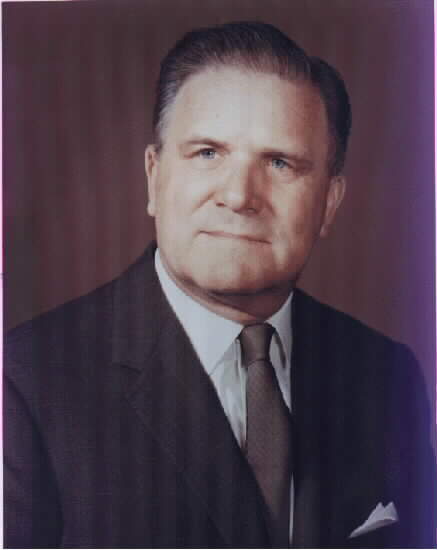From a contemporary press report:
James Edwin Webb, the hard-charging and immensely capable administrator who was head of National Aeronautics and Space Administration from 1961 to 1968, died March 27, 1992 at Georgetown University Hospital in Washington, D.C. after suffering a heart attack. He had Parkinson’s disease.
Mr Webb, 85, had a long career in both public service and private industry. During the Truman administration, he served as director of the Budget Bureau and as an Undersecretary of State. He also had been a Deputy Governor of the World Bank and the International Monetary Fund.
After spending the Eisenhower years in private industry, he was asked to become chief of NASA by Vice President Lyndon Johnson. Though reluctant to take the post – he thought an engineer or scientist might be a better choice-he eventually accepted. He took over an agency that was in its administrative infancy. Established in 1958, the agency almost literally aimed for the stars. His first mandate, which he received from President Kennedy, was to put a man on the moon. Though he stepped down as administrator a year before Apollo touched down on the lunar surface, he was universally credited with laying the groundwork for that epic event.
Mr Webb was chosen administrator for his management skills and his political sophistication. At NASA, he was perhaps more admired than loved, gaining a reputation for bullheadedness, and he seemed to relish keeping the staff
somewhat off-balance, a management technique he called “planned desequilibrium.” He reined in NASA administrators and scientists alike, gaining a legendary mastery over small details. When called before Congressional committees, he tended to bury them in loud and fast-talking testimony and seemingly endless streams of data. He needed more than a few of these talents to preside over an agency that came to include 35,000 staff members and about 400,000 contractors from 20,000 companies.
Mr. Webb explained some of his management techniques to a Washington Post reporter in a 1981 interview. He said that when he joined NASA, as a lifelong Democrat and agency outsider, he had to work with two deputies. One, Hugh Dryden, had been head of the National Advisory Committee for Aeronautics; the other, Robert Seamans, had been named to the office by the Eisenhower administration.
He told The Post, “We needed to work together, so here’s what I decided: No policy would be approved for NASA until the three of us had talked it over. None of us would do violence to the strongly held opinions of the other. This was a policy which intentionally put us in chains. We bound ourselves in these hoops of iron. Sure, I could have overruled them. I was the boss. But it wouldn’t have worked that way.”
His mastery over Congress and his agency reached the point where he could complain to Kennedy about one of his chief staff members and to President Lyndon B. Johnson about “your Vice President,”, Hubert H. Humphrey, and come out the winner. Though the agency grew by leaps and bounds and was one of those true rarities, a federal agency popular with both Congress and the public, he never took on the trappings of celebrity himself.
He returned a limousine sent to him by the General ServicesAdministration, riding around town in a trademark black Checker cab. His darkest hour with NASA was probably January 20, 1967, when three astronauts died on the launch pad in an Apollo craft. Mr Webb spent the next several months answering critics, including congressional committees, on possible blame for the tragedy. In 1968, he announced that he was retiring. At a September news conference, he deplored congressional budget cuts for NASA at time when the Soviet space program seemingly was growing.
After leaving NASA, he undertook projects for the Smithsonian Institution and National Geographic.
James Edwin Webb, a native of North Carolina, graduated from the University of North Carolina in 1928 with a degree in education and a Phi Beta Kappa key. He studied law at George Washington University and was admitted to the D.C. Bar in 1936. He joined the United States Marine Corps Reserve in 1930, received his wings the following year and spent part of World War II as a Marine Corps aviator.
From 1932 to 1934, he was secretary to Representative Edward W. Pou (D-NC), Chairman of the Rules Committee. Later in the 1930s, he worked for O. Max Gardner, a former North Carolina Governor who was General Counsel of the Aeronautical Chamber of Commerce of America.
From 1936 to 1943, he worked for the Sperry Gyroscope Corporation, becoming its Vice President.
After World War II, he practiced law before serving as Budget Bureau Director from 1946 to 1949 and Undersecretary of State from 1949 to 1952. He then was a director of Kerr-McGee Oil Industries and McDonnell Aircraft, and President and Board Chairman of the Oak Ridge Institute of Nuclear Studies before becoming NASA chief.
Survivors include his wife of 53 years, the former Patsy Aiken Douglas, of Washington, DC; a son, James Jr., of Stockton, New Jersey; a daughter, Sarah G. Webb of Santa Fe, New Mexico; two brothers, Henry G., of Kensington, and John F. Webb Jr. of Oxford, North Carolina; a sister, Olive Webb Wharton of Durham, North Carolina; and a granddaughter.
Public Servant.
October 7, 1906-March 27, 1992
Buried with full military honors in Section 2 of Arlington National Cemetery.
Michael Robert Patterson was born in Arlington and is the son of a former officer of the US Army. So it was no wonder that sooner or later his interests drew him to American history and especially to American military history. Many of his articles can be found on renowned portals like the New York Times, Washingtonpost or Wikipedia.
Reviewed by: Michael Howard

